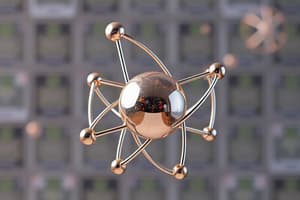Podcast
Questions and Answers
Which block of the periodic table corresponds to the transition metals?
Which block of the periodic table corresponds to the transition metals?
- d-block (correct)
- p-block
- s-block
- f-block
What is the characteristic orbital for the f-block in the periodic table?
What is the characteristic orbital for the f-block in the periodic table?
- diffuse
- sharp
- principal
- fundamental (correct)
Which group of elements are usually considered main-group elements?
Which group of elements are usually considered main-group elements?
- g-block
- f-block
- s-block and p-block (correct)
- d-block
Why are zinc, cadmium, and mercury sometimes regarded as main group elements?
Why are zinc, cadmium, and mercury sometimes regarded as main group elements?
Why are the group 3 elements occasionally considered main group elements?
Why are the group 3 elements occasionally considered main group elements?
Flashcards are hidden until you start studying
Study Notes
Periodic Table Classification
- The d-block corresponds to the transition metals.
f-Block Characteristics
- The characteristic orbital for the f-block in the periodic table is the f-orbital.
Main Group Elements
- Main-group elements typically consist of the s- and p-block elements in the periodic table.
Borderline Cases
- Zinc, cadmium, and mercury are sometimes regarded as main-group elements due to their chemical properties, which are similar to those of the p-block elements.
- The group 3 elements (Sc, Y, La, and Ac) are occasionally considered main group elements, although they are formally part of the d-block, as their chemical properties resemble those of the main-group elements.
Studying That Suits You
Use AI to generate personalized quizzes and flashcards to suit your learning preferences.




